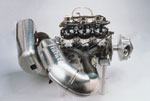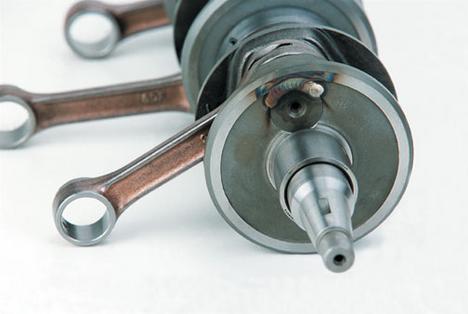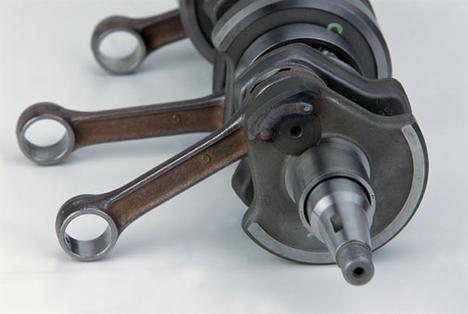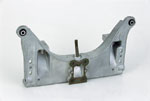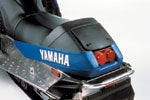|
Yamaha pulled out all the stops for the 2002 Vipers. Their is not doubt in this Editor's mind that the Viper will be the hottest sled for 2002 and most likely for 2003. We'll go into the details of the new model later in the article and you can see all the specification sheets also, but I want to discuss some of the more intangibles about the snowmobile first. One being this is one beautiful snowmobile with a fit and finish that is more European sport sedan than Japanese snowmobile. I'm a very particular person and I always go over everything I buy with a fine tooth comb looking for the slightest imperfection. My biggest pet peeve for snowmobiles is paint and decal scheme. I expect the manufacturers to deliver a fully painted cowl with out runs or areas where the finish is not consistent. When I picked up my new Vipers, you can read about it here by clicking this sentence, I went into critical review mode. I was impressed and grinning like a Cheshire cat once I saw the snowmobiles in person. I wasn't able to participate in any prerelease events prior to the snowmobiles being delivered to the dealers. The finish of the blue was crystal clear and had a depth like a hundred coats of lacquer was applied. The finish was consistent over the entire snowmobile and the decals were of the highest quality. Not all manufacturers can attest to this like Yamaha can. The red Viper was on par with the blue Viper and was absolutely gorgeous. From the factory, both of these snowmobile processed the best paint finish, depth of color and clarity, that I have ever seen on a snowmobile. The decals are extremely tasteful and excellently applied and complement the overall paint finish nicely. The snowmobiles did have a few minor imperfections, but I can say with any confidence whether they were caused by shipping in the new steel crates or during dealer prep. The first thing we found was a lug on the track that was partially torn. I doubt this could have happened when we loaded or unloaded the sled at the off-road.com barn in NY state. I hope this is not an indication of the Yokohama tracks reliability. The other flaw was a paint scratch on the red Viper's left trailing arm. Overall the snowmobiles were delivered in perfect condition. According to Yamaha's press information we received, "The sound, look and feel of the new 2002 Yamaha Viper is pure addiction. One venomous bite is all it takes for performance junkies to discover that this is one serious machine. Cutting edge styling flows back from the sculpted nose--past the twin beam, white-light head lamps --accelerating into the forced air induction intakes -- and swirls beyond the sculpted seat and twin R1 motorcycle taillights. Underneath this art in motion is the industry's most advanced and rigid chassis." This may be over the top for anyone who doesn't sleep in Yamaha underwear, but they do sort of capture the 'feeling' this snowmobile is going to generate. It's downright sexy and looks meaner than hell at the same time. What's New? In a nut shell, only a few very significant items are truly new, but the items that are new are engineering marvels. This is clearly a case where the end product is more than a sum of its parts. Many of the Vipers components and shapes are taken from other models or carried forward from the VMAX, SX, and SRX models from the last few years. You'll recognize the familiar shape of the VMAX hood, but it looks very different with the aggressive air intakes and hoods vents of the Viper. The graphic below is the big picture of all the key features that are new on the Viper. I'll point out some of the most important items that are new or are so improved from previous years they can be considered new.
All Those Wonderful Engine Changes!
The engine is based on the legendary SRX motor, but it's 696cc triple powerplant is new from the case up. The engine shares some of the similar design attributes of the SRX. The triple exhaust ports are smaller versions of the SRXs, but the cylinder castings are more compact than the SRX making the cylinders lighter. The Vipers exhaust ports are also CNC machined which helps provide more consistent power curves. Along with the cylinder castings being lighter in weight, the one-piece head on the Viper reduces weight even further. The Viper is also the first Yamaha to offer varied compression ratios by cylinder. The #1 cylinder ration is 5.9:1 while the #2 and #3 cylinders ratio is 6.7:1. You'll use the same main jet sizes on all the cylinders as you add pipes or silencers to the Viper. The issues of staged jetting are completely eliminated. Almost as good as fuel injection. The weight savings continue within the engine with the crank shaft. The Yamaha tradition of using heavy duty duplex rollers continues as well as crankshaft welding to provide extra strength. The new design remove material from the crankshaft where it's not needed to reduce rotational weight by 1.5 pounds. The improvement that you'll notice the second you fire up your Viper, is the new ignition system. The 18-pole stator design delivers a whopping 300W of power for the brightest whitest light on the market. The 360° D.C. ignition system also fires each plug separately for strong and consistent spark. To continue still with Yamaha's weight saving measures, rare earth flywheel magnets are used like in the SRX. Rotating mass is reduced by 2 pounds. The end result of the new system is a better timing curve that increases low-end power and throttle response. The lights also never dim when the snowmobile is idling. Feeding the Viper is a trio of Mikuni TM33 flat slide carburetors. As before the carburetors are liquid heated, which is supposed to increase fuel economy. The Viper also has a throttle position sensor which increases low-end horsepower. The carburetors are also vented directly to the airbox to allow for pressure adjustments due to the forced air induction. The forced air induction has turned into a significant marketing tune is more hype than power when you peel back the layers of the onion. A few things you need to know about this system. One, the system does not force air from outside the snowmobile directly into the airbox. You'd be cooking pistons all day long from powder getting into the airbox and then snow and water going into the combustion camber. Two, the system does force air into the engine compartment which in turn does raise the volumetric pressure within the airbox. Three, this alone does provide a top-end horsepower gain of around 2 to 3 horsepower. The Viper clutching has been thoroughly been worked on also. The new clutch calibrations increases clutch weight generating 30% more force during acceleration than lasts years SX 700. The greater V-belt forces also generates faster shifting for quicker acceleration. The clutch is now set with a mounting angle of 0.4°. The increased V-belt pull force on the engine mounts will pull the clutches into perfect alignment. The net result is increased V-belt life and efficiency. An engine pre tensioner is available from Yamaha that would allow a 0.0° mounting angle. One last engine item before we move on is another weight saver. The recoil starter is 15% lighter and larger than last years SX 700. 132 mm versus 114mm, making the Viper an easy starter. Chassis and Suspension
The reoccurring theme continues to be weight savings. Numerous changes to the frame, bulkhead, cooling system heat exchangers and the generous use of aluminum have taken another 4 pounds off the chassis. The engine is set lower in the chassis than last years SX 700 lowering the center of gravity and improving cornering characteristics. Small details that helped remove weight are the aluminum rear bumper design and the bracing in the engine compartment. The Vipers front suspension is equipped with KYB high pressure gas shocks, multi-rate springs, and a hefty anti-sway bar. The new cast bulkhead is flex free allowing the use of larger ball joints and radius rods. Most of the front suspension components are forged aluminum to reduce weight again. The rear suspension is the tuned up ProAction skid frame with KYB high pressure gas shocks. The adjustable control rods aren't new, but they are designed a bit differently than past models. I'd replace them with the Bender Racing adjusters to make them extremely easy to adjust on the trail. Another area of the chassis and suspension that is all new for 2002, is the the track. The Yokohama designed and manufactured track has a new design just for the Viper. The lug material is stiffer than the rest of the track and the outside portions of the track as also slightly thicker than the rest of the track. The reduced weight and design is supposed to increase acceleration. I would have preferred a 1" Camoplast Predator track like some of the other Yamaha model received this year. Some More Really Neat Stuff! The Instrument Panel
I've always been an analog man, but the new instrument panel on the Viper is one tasty addition. Based on the R1 motorcycle instruments, but modified for cold weather use, the unit has all the needed information displayed on compact yet readable display. The accuracy is dead on with the use of a stepper motor tachometer drive system. I think the reason this works so well is the tachometer is still analog while the speedometer, fuel gauge, dual tripmeters, fuel, oil, water, and check engine light are digital. The Weight Watchers′ mentality of Yamaha is shown again, the new gauge package is 2.3 pounds lighter than the SX 700 gauges. Lighting
As I mentioned before the headlights are the whitest and brightest I have ever seen. They never dim and the offer a few neat tricks also. When the hood is open and the engine running, the headlight will illuminate the engine compartment. A nice touch for the occasional plug change or system check while out at night. The taillight also illuminates the cargo compartment in the seat. No other snowmobile manufacturer offers these niceties. Seating
The Vipers new seat deserves to be pointed out. The seat is a Lazy-Boy′ for the hind quarters. The new seat is not overly sticky, like the MXZ seats, and provides just the right amount of firmness to be comfortable on a 200 mile day. The drivers position is roomier than the 2000 SX 700 seat and the seat material covers more of the tunnel this year also. The new seat offers a larger trunk, which is lighted, and a secure location for the tool kit Not just a hollowed out location, the tool kit can be secured in the position with a fastener. You can guess what I'm going to say next, the seat is also 23% or 3.3 pounds lighter than the SX 700 seat. Fuel and Oil Consumption The last item that really impresses me is that not only has Yamaha pumped 18 additional horsepower into the new Viper engine, it used 1/2 the oil and gets 15% better fuel consumption. That is impressive. The SRX derived oil pump has significantly reduced oil use while driving in the 25 mph to 45 mph range. The oil cap is also larger, a much needed improvement, at 2" in diameter. Conclusion You've made it to the bottom, I apologize for the length, but their is some much to write about when the Viper is concerned. The Viper is truly an engineering wonder that stirs emotions every time I look upon it. The fit and finish is pure Yamaha, flawless. I've never been so excited about a sled that I never actually spent time in the seat of. That is a pretty powerful statement, but you can surmise that the Viper is not going to disappoint. Just by studying all the improvements that have been poured all over the Viper you can assure yourself this is one amazing machine. Lots of people are going to be disappointed with the Viper however, they're not going to be able to get one. The Viper is going to be a rare site on dealers floors. If you haven't already purchased one, you may be faced with having to buy the SRX or SX 600.
Engine Performance
Handling
Comfort/Convenience
|
||||||||||||||

